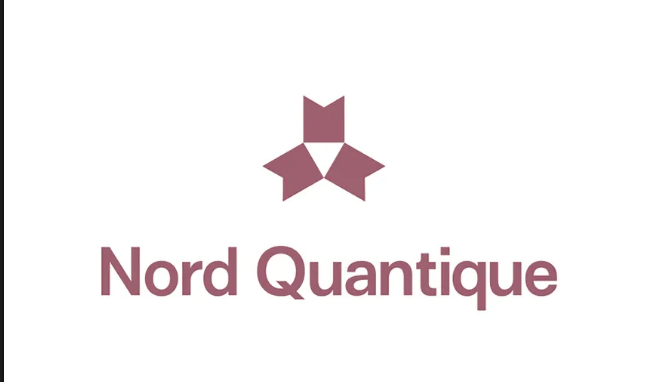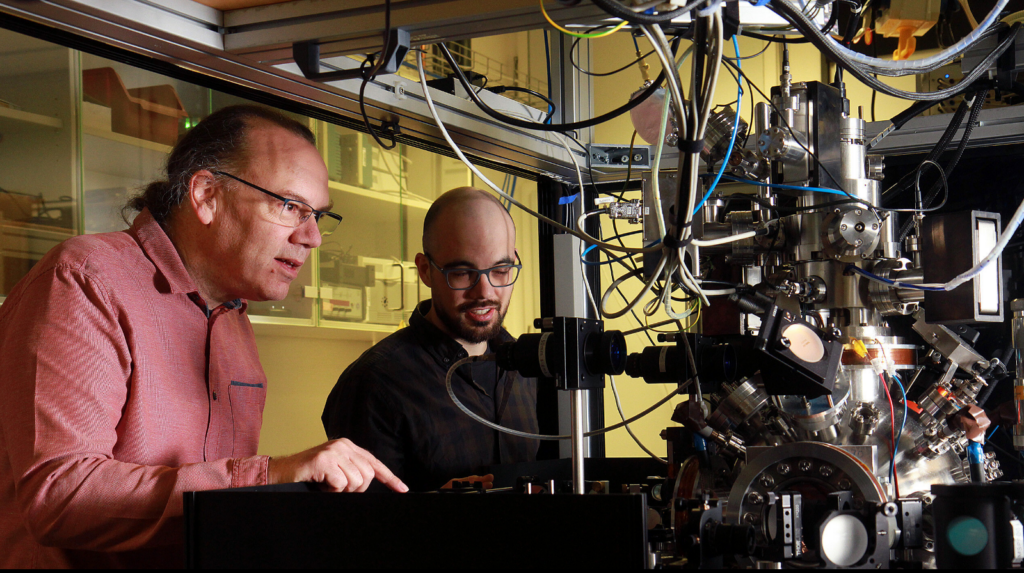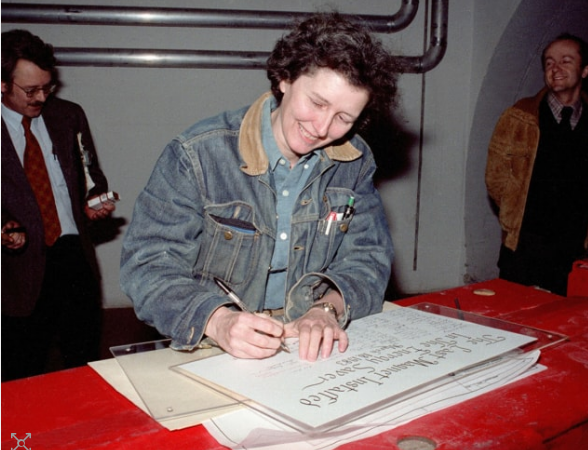
STEM FIELDS’ WOES
Traditionally speaking, science has been the pursuit of men, both in the academic and experimental side of things. This has started changing, however, with the number of women in STEM fields (e.g., science, technology, engineering, and mathematics) growing over the last few years (though many complain it is still too low proportionally speaking).
The UCAS infographic below summarizes the male/female ratio of graduates for core STEM courses and, though the statistics are taken in a British context, the pattern is similar across the board in the developed world.
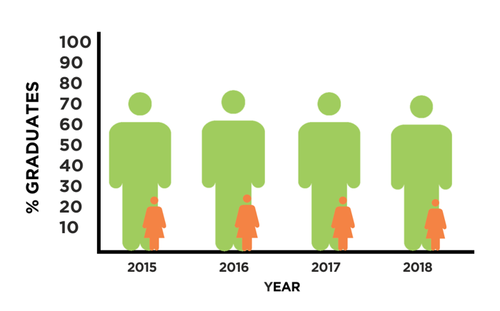
Things are changing, though.

For such a new discipline (as disruptive technologies go), quantum computing (QC) is well represented by women who are changing the landscape. Below I list, in no particular order of influence, professional achievements or potential, twelve brilliant women who are shaping the QC landscape through innovation, ethics, sheer genius and determination. Similar to our list of top QC research universities, this list is by no means exhaustive.
So let us begin with these superwomen of the subatomic world that one day may alter our lives irrevocably.
REBECCA KRAUTHAMER
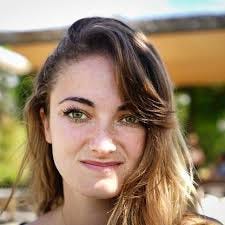
‘I’m passionate about Artificial Intelligence and ethics, connecting people who can make great things happen together, building cutting edge technology that truly improves life for all people, and bringing out the best in people and teams.’
— Rebecca Krauthamer
Quantum Thought, founded at the beginning of 2019, is a leader in ‘quantum application development for cybersecurity, AI, and precision medicine’.
QuSecure’s business model, meanwhile, focusses on secure quantum applications for businesses.
Rebecca’s experience in AI and the startup scene in Silicon Valley, together with her venture into the QC space with her two latest startups, will be crucial if she — along with her team — is to execute a successful company or gain the attention of hungry VCs in the space.
ARACELI VENEGAS-GOMEZ
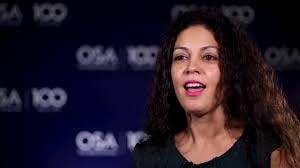
We Speak Quantum
— Qureca
Venegas-Gomez’s CV includes stints at Stanford University as a visiting Ph.D. researcher and — going way back in the day to 2008 — at the University of Salzburg, Austria. Before all this, Venegas-Gomez started off as an aerospace engineer. Oh, and by the way, she also has an OSA fellowship to add to her impressive roster of achievements!
SABRINA MANISCALCO

Black and white in cultural terms.
A professor at the University of Turku and Aalto University, and the Vice-Director of the National Centre of Excellence in Quantum Technology, Finland, Maniscalco’s Ph.D. was in theoretical physics. A well-travelled academic, she has had teaching stints in Bulgaria, South Africa, as well as Scotland.
‘My biggest success is definitively my group: the people, the spirit and the wonderful research atmosphere. I don’t have any main regrets. I only wish I would have more time for research.’
— Sabrina Maniscalco
At the end of last year, Maniscalco and her team at Aalto and Turku universities began a collaboration with IBM and its Q Network to work on new applications to teach and inform younger people about the potential of quantum technologies, eventually creating open-source material for them to use.
On the cooperation, Maniscalco said:
‘We’re creating an interactive online mnemonic medium, intended to augment human memory, which incorporates and combines videos, short games, text, simple math, and computer programs, all with the aim of building the knowledge of quantum phenomena.’
An author of 191 publications as of January 2020, her latest offering, co-authored with Guillermo Garcia-Perez and Matteo A. C. Rossi, IBM Q Experience as a versatile experimental testbed for simulating open quantum systems, seems to be the findings on the collaboration.
With her enthusiasm for the field, let’s hope Maniscalco continues making headlines in popularizing quantum technologies.
HANHEE PAIK

When you’re employed at one of the world’s most iconic tech companies, you’re going to get noticed for the work you do. Hanhee Paik is no exception.
A South Korean national, Paik gained a Master of Science degree at Yonsei University, South Korea, before completing her Ph.D. at the University of Maryland College Park. Further postdoctoral work followed until she moved to Yale University. In 2012, Paik left the academic world for the business arena and to BNN Technologies as a scientist specializing in quantum computing research. Two years later, she landed the gig of all gigs as a research staff member Yorktown Heights’ most famous company.
Quantum Starts Here
— IBM
Since that time, she has gone from strength to strength. Her focus, unwavering throughout her career, has been to get to grips with, and improve upon, the coherence mechanisms of superconducting qubits, solid-state devices and quantum communication.
IBM, then — the world leader in the superconducting approach to bringing reliable, cost-effective quantum computers to the mainstream — is a perfect fit for Paik, who will use her acumen to make IBM, I’m sure, a preeminent player in the space.
ANDREA RODRIGUEZ BLANCO
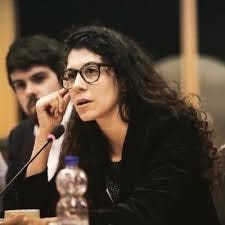
Next on the list is a woman I interviewed for TQD late last year, Andrea Rodriguez Blanco, founder of Spanish QC startup Q-Lion.
Q-Lion was founded in 2019 and is the first Spanish startup focused on, the development of quantum error-correcting codes.
Q-Lion has won best project in the incubator program Explorer by Santander Bank (Ganador Premio Explorer UCM, in Spanish), adding prestige to the early startup’s already growing reputation in the space.
Rodriquez Blanco leads a small team of quantum software engineers, quantum communication, research and administration specialists. A candidate at the Universidad Complutense de Madrid with a background in physics as an undergraduate, Q-Lion is currently developing distance three fault-tolerant topological colour codes operating with just two auxiliary qubits.
‘Spain has always had really great theoretical physicists that have contributed to the field of quantum computing and also some Spaniards such as Dario Gil, Sergio Boixo and Elisa García Anzano leading areas of quantum computing at IBM, Google and Microsoft respectively.’
— Andrea Rodriguez Blanco
At the tail end of last year, she was in Silicon Valley hoping to raise capital for the startup.
One can only hope the hard work pays off, and Q-Lion — just like the name it represents – can become a king of the QC jungle.
MICHELLE SIMMONS
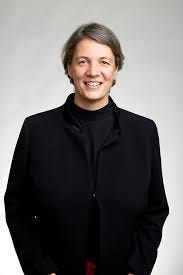
British-born Aussie Michelle Simmons is a Scientia Professor of Quantum Physics at the Faculty of Science at the University of New South Wales and has twice been an Australian Research Council Federation Fellow. She is also an Australian Research Council Laureate Fellow.
What’s more impressive, however, is that in 2018 she was awarded the illustrious prize of ‘Australian of the Year’. She got this for her work in quantum information science. With a medal cabinet as big as Hollywood star and World War Two veteran Audie Murphy, Simmons is well regarded in QC research.
‘Throughout my career, I found people often underestimate female scientists.’
— Michelle Simmons
Educated at Durham University where she studied physics and chemistry of materials, Simmons completed her Ph.D. at St Aidan’s College.
After university, in the early 1990s, Simmons became a Research Fellow in quantum electronics at Cavendish Laboratory. Later, she moved to Australia when she was awarded a QEII Fellowship. It was in Australia that Simmons founded — along with others — the Australian Research Council Centre of Excellence for Quantum Computation and Communication Technology.
In 2017, Simmons was instrumental in the formation of Silicon Quantum Computing (SQC) and continues to lead the company as Director, CEO and Lead Researcher. SQC was founded with $82.7m in equity capital from five foundation shareholders: Commonwealth Bank of Australia, Telstra Corporation, the Australian Commonwealth Government, the NSW State Government, and UNSW. The Company is working using Simmons’ Atomic Precision Manufacturing techniques to build a quantum processor in silicon and eventually a useful quantum computer.
KAREN HALLBERG
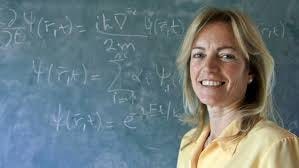
Born in Rosario, Argentina, Hallberg has spent the greater part of her career at the Bariloche Atomic Centre, a renowned research community situated in the foothills of the Andes , close to the border with Chile, and far away from the hustle and bustle of Buenos Aires.
As a child at school, she was apparently known as ‘señorita por qué’ or ‘Miss Why’ in English. Studying electronic engineering at the National University of Rosario, she got her Ph.D. in ‘computational models of quantum materials that demonstrate low dimensional magnetism and superconductivity’, at the Balseiro Institute, a research institute connected to the National University of Cuyo, in Mendoza.
After her Ph.D., Hallberg moved to Germany and the prestigious Max Planck Institute for Solid State Research as a postdoctoral researcher.
As a physicist, Hallberg has always focussed her attention on developing computer simulations to understand quantum matter, while also taking an active interest in conductivity, superconductivity and magnetism.
Just as important, however, has been Hallberg’s outspoken stance on getting more women actively involved in the sciences in Latin America and the wider world. Awarded the L’Oréal-UNESCO For Women in Science Award in 2019 for her efforts, the prize is well deserved.
‘Physics, for example, is among the scientific careers that, regrettably, has the lowest participation of women.’
— Karen Hallberg
Like Simmons, her contributions to the academic side of the QC industry couple with her tireless work in inspiring more women to enter the STEM subjects, has solidified her place on this list.
JESSICA POINTING
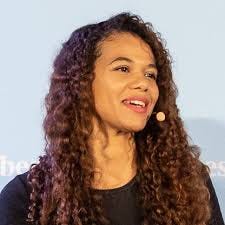
Every industry needs a Rockstar-like representative, a person who can elevate it to the consciousness of the masses so that they understand its importance to humanity.
Nigel Kennedy did it with the violin.
Tony Hawk did it with skateboarding.
Henry Ford made the automobile a commodity we just couldn’t live without.
And of course, Richard Feynman and his magical lectures on quantum physics that, more than thirty years after his death, are still talked about in the halls of Caltech.
All these icons, funnily enough, have one thing in common: they were all popularizers of a thing, or a movement.
Feynman’s achievement, more than any other — especially talking in a pedagogical context of it — was an extremely difficult thing to do. Yet he managed it, more to the man. For a lot of people, the sciences are– no matter what the discipline — boring, opaque and without much sense.
Talent can change all that, like in Feynman’s case, by giving the average Joe a way inside the gate to appreciating the utility of the thing or understanding it.
Stanford Ph.D. student Jessica Pointing is such a person. Like Rebecca Krauthamer, Pointing is also Forbes 30 Under 30 Alumni.
Pointing’s YouTube videos of her keynote speeches around the United States and beyond are a pleasure to watch, especially for young people:
‘Smart young girl, well explained. Keep up with [sic] the good job!’
— Gracily Love, YouTube fan of Jessica Pointing
Pointing provides clear presentations on quantum physics and quantum computing, something many in the field fail to achieve with their chalkboard-type explanations of signs and symbols.
Born in Reading (UK), Pointing moved to Denmark and the Copenhagen International School when she was 15. In 2014, she went to MIT where she studied for a bachelor’s degree in physics and computer science. Harvard beckoned next, where she achieved another bachelor’s degree in physics. After successfully completing the course at Harvard, Pointing crossed the continent to the sunny skies that are California for a Ph.D. in quantum computing at Stanford University, which she is currently completing.
A poster child of sorts for the nascent industry that is still finding its feet in a world full of detractors, Pointing has delved into the environment outside the ivory tower of academia with stints as an intern of investment banking at Goldman Sachs, software engineering at Google and management consulting at McKinsey & Company.
‘Ask yourself why you do what you do. If you know why you’re doing it, you have a purpose, a direction, a goal. This can help when you encounter a challenge. It becomes clear how to best approach it.’
— Jessica Pointing
The story of this British girl has yet to be told. But I put my bottom dollar on it that a great future awaits her in the QC industry. Oh, and did I mention that she’s just 24 years old?
ANA MARIA REY
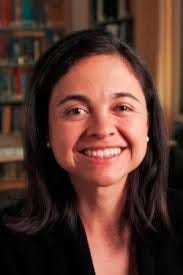
Colombian native Ana Maria Rey, a theoretical physicist and professor at the University of Colorado at Boulder and a JILA fellow, is on a mission. For one, she is the first Latin American female to become a National Award winner of the Blavatnik Awards for Young Scientists, in 2019.
Gaining a bachelor’s degree in physics at the Universidad de los Andes in Bogotá, she immigrated soon after to the United States. Four year later she had completed her Ph.D. in physics at the University of Maryland, with her dissertation Ultracold bosonic atoms in optical lattices supervised by advisors Charles W. Clark and Theodore R. Kirkpatrick.
‘I try to understand how atoms and molecules when they are brought to very, very low temperatures… or whether they are pulled down to… almost below one million degrees of a kelvin could be used to simulate the behaviour of electrons in solids. Or could be used to make better clocks. Or could be used for quantum simulations and quantum information. Can we make with them a better computer?’
But all this was only the start of her adventure in the world of quantum physics. Following her advisor Charles W. Clark to Colorado and The National Institute of Standards & Technology (NIST), where she focussed her attention on optical lattices and ultracold systems. For two decades she has made breakthrough after breakthrough in these fields, leading the charge into creating better materials for superconductors, which could, if successful, lead to quantum computers operating at room temperature, vastly lowering the price of producing them.
Rey is also the founder and leader of the Rey Theory Group, a research collective dedicated to finding the interface ‘between atomic, molecular and optical physics, condensed matter physics and quantum information science’.
ILANA WISBY

Ilana Wisby is the CEO of Oxford Quantum Circuits (OQC). OQC was founded in 2017 by Dr Peter Leek as a spinout startup from Oxford University. Its aim is to develop superconducting circuits and then commercialize quantum computers in the UK and the world.
TQD journalist Matt Swayne recently interviewed Wisby, where we talked about her vision for the business:
‘Our vision is to build a truly scalable, flexible quantum computer. We’re building the quantum computer itself, as well as the qubits, based on technology that was developed by Dr. (Peter) Leek at the University of Oxford, where the company started. And that’s really the core of what we do.’
Ilana’s enthusiasm for the way the industry is heading is infectious, though that doesn’t mean she has misgivings, especially regarding the false promises à la Google and their claim of reaching Quantum Supremacy back in October of last year:
‘For example, though many in the industry focus on the number of qubits as a sign of the computational power of a quantum computer, it may not necessarily be an accurate benchmark, let alone a complete one, of the computer’s overall performance.’
Head screwed on to the false prophets in the industry, let’s give Wisby respect for not believing the bullshit-hype coming from many so-called experts.
KRYSTA SVORE
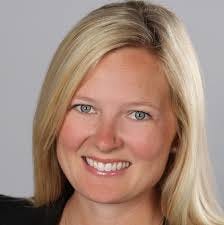
Krysta Svore needs no introduction. Of all listed, maybe she’s the most high profile, the one that has received the most exposure since the hullabaloo of QC began.
At least in the sense of media coverage, with her keynote speeches, a particular treat to watch.
Svore’s educational background includes a B.A. in mathematics from Princeton University in 2001. Five years later, she obtained her Ph.D. in computer science from Columbia University under the guidance of Dr. Alfred Aho and Dr. Joseph Traub.
‘We want to really open up quantum computing to a broad audience, make it accessible to everyone. And so, the idea is that you need not know quantum mechanics. You know, after all, I’m in this field, I’m a computer scientist. I’m not a physicist. I did not take quantum mechanics in college…’
— Krysta Svore, Microsoft Research Podcast, 2018
Svore is currently the General Manager of Quantum Software at Microsoft and head of the Quantum Architectures and Computation (QuArC) group. Her main area of expertise is in designing and developing quantum algorithms, web search and information retrieval, scalable, fault-tolerant software and working on quantum error correction codes.
ELEANOR RIEFFEL
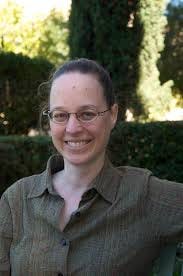
Last but not least, we have Eleanor Rieffel, a Research Computer Scientist at NASA Ames Research Center. With a Ph.D. in mathematics from the University of California, Los Angeles, her interest in quantum computers dates back to the latter half of the 1990s. At the time she read numerous papers on the subject and came to the conclusion that the discipline blended all the best that computer science, mathematics and physics had to offer.
That was all she needed to take the next step.
For sixteen years she worked as a Senior Research Scientist at FX Palo Alto Laboratory until she moved to the NASA Ames Research Center in 2012.
Her scientific research focuses on many interesting and diverse fields. These include quantum computation, applied cryptography, image-based geometric reconstruction of 3D scenes, bioinformatics, video surveillance, and automated control code generation for modular robotics.
Her scholarly works, like the disciplines she is interested in, are too numerous to name, but she has written a book, Quantum Computing: A Gentle Introduction, published in 2011 and co-authored with Wolfgang Polak, which I will be providing review of shortly.
Final Thoughts
For more information and data, we recommend the following section of the STEM Women website. This should be enough to show you that there’s plenty more to be done to address the gender imbalance in STEM. Let us hope, then, the years ahead give birth to many women in QC, similar in calibre to the twelve special ones above.













